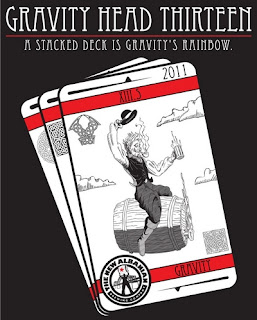Apologies for some of these pictures being blurry, the light is low and my lens is not so good.
First Course: Smoked Salmon Stuffed Potato Nest paired with Hop Bomb IPA
Why it worked: If you haven't had the Hop Bomb IPA at the downtown Rock Bottom yet, you need to. This was the last of the current batch and it may not be back for a few months, but this is really one of Indiana's great Double IPAs. The base of this entree was a whipped salmon infused cream cheese that was incredibly decadent and delicious. The immense hop presence in the Hop Bomb helped cut through the creamy texture of the cheese. The cream cheese itself was seasoned with lemon zest and carried a bit of a citrus note as a result, which paired very well with the grapefruit, orange and lemon notes in the beer, while the grassy notes were a nice compliment to the meaty aspect of the salmon. Citrus and grassy notes tend to work well with fish, and when you add a rich cream or cheese in to the mixture (or even a fatty fish like salmon), hops are provide an excellent cleansing ability.
Second Course: Lobster Bisque paired with Raccoon Red Ale
Why it worked: This dish would perhaps be better described as a lobster tomato bisque, as the pureed tomatoes carried a much more dominant role than I had expected. When I saw the description of the dish, I wasn't sure how a sweet, malty red would work with this, but the tomatoes seem to be the answer to the puzzle. The sweet tomatoes and the caramel and nutty malt flavors of the beer paired together very nicely. While they didn't introduce any new flavors together, the well balanced profile of each made for an enjoyable match. When pairing sweet beers with sweet foods, the danger lies in creating a combination that is simply too sweet to be enjoyable, but with the light balance of hops and the sweetness of the soup coming from tomatoes instead of sugar, this was a well balanced pairing.
Third Course: Rosemary Duck paired with Trouble Belgian Tripel
Why it worked: I am a huge fan of duck. Duck provides a wealth of rich flavors with little necessary spices to coax additional flavors out of it. I was quite pleased when I saw that the entree was not one, but two duck breasts. The breasts were on the lean side and even though they were cooked medium well (I prefer medium rare), they were excellent. This was my food highlight of the meal. The Trouble sits on the spicier side of tripels, with a noticeable touch of alcohol in the back. When paired with the duck, something really exciting happened. It was almost as if the clove, cinnamon, anise and rock candy notes in the beer actually seasoned the duck. None of the spices conflicted with the rosemary rub, but they all gave it a nice burst of flavor that was not there on its own. Beer can often provide additional flavors or seasoning to different types of meat, but it is important to note the flavor profile of the beer and ensure that those characteristics are things you would season the meat with on its own. In this case, cinnamon, clove, anise and sugar are all used in different duck dishes, and worked great when provided by the beer.
Fourth Course: Strawberry Mint Spring Rolls paired with Hoosier Ma Stout
Why it worked: The Hoosier Ma Stout rotates its style, and is currently an English stout with notes of chocolate and coffee. If I were to pick a pairing of the evening that fell a bit short, it would probably be this one. English stouts tend to be on the drier side, and the strawberries and their glaze were simply too sweet to work with the dryness of the stout. All was not lost, however. The dish was seasoned and garnished with a bit of fresh mint leaves, which provided a nice cooling mint sensation that paired well with the dry chocolate notes of the stout without overpowering any of the flavors of the beer. Dry beers typically don't work very well with sugary dishes, but they do lend themselves very well to herbal flavors, which worked great here.
Pairing Lessons: Foods that have a relatively high percentage of fat often work well with hoppy beers, due to their ability to cut through thick flavors. You can never go wrong with pairing similar flavors either, providing neither are incredibly intense. Citrus pairs with citrus, sweet pairs with sweet, etc. Try to keep things in check, though. You don't want too much of one flavor going on or the pairing will appear one dimensional. When pairing beer with meat, always choose a beer that has tasting notes similar to things you might add to the meat, whether it be spices or side dishes. Belgian beers tend to work great for this reason. Dry beers can be overpowered very easily, and they aren't sweet for a reason. Focus on creating subtle balance and accenting flavors and avoid drowning the beer out with big sweet or spicy flavors.


















































